Introduction
Push-ups are a very basic exercise. They are also very efficient to improve your physical condition. It’s one of those basic exercise that is practiced in almost every sport.
Push-ups are the symbolic exercise of military as well as fighters of all kind.
Why is that ? Why this simple exercise became a referent one ? How to practice push ups correctly ? What are the different methods, programs, variations and benefits of this exercises ? That’s what we will answer to in this article.
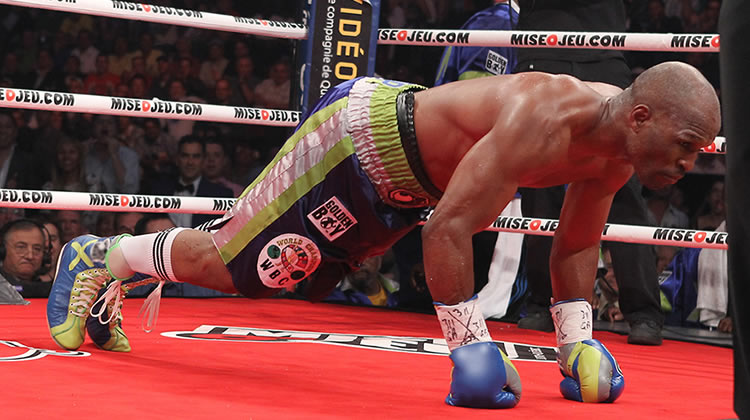
Push-ups can be practiced as a warm up or can be a stand alone exercise for a full session. It can also be integrated into a longer session. They can be done in dozen different variation. And you can do them anywhere !
What are push ups ?
Push up are a muscular reinforcement exercise using the weight of the body. It’s an exercise using mainly the pectorals, the deltoid and the triceps and the core for stability.
It is very popular because it’s one of the most efficient upper body exercise. You can do it anywhere since you just need your own body.
There are a lot of variations of push up, we will first study the classic push up.
The perfect classic push up
Lay on the floor on your stomach. Place your hands on the floor as wide as your shoulders. Keep your elbow from flaring. Hold them against your body. Once the core is fully locked, push to elevate your body until your elbow are locked. Then go back down until your chest is only a few centimeters from the ground.
That’s one repetition !
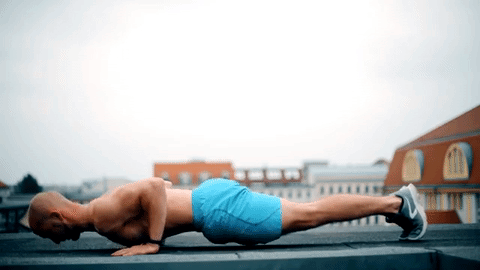
A few tips to keep a good form.
Maintain a strong grip
Anchor your hands in the floor like you’re trying to rip it open. Push down like you are trying to go through the ground while twisting your palms outwards. Your biceps and elbows should be now parallel to your body. Don’t flare your elbows. It will increase the charge on your triceps and pecs rather than on the shoulders. Doing so will reduce potential injuries.
Keep neck and spine aligned
Visualize a line going from the bottom of your back through your neck and the top of your head. You want this line to stay as parallel to the floor as possible. It will prevent potential injury and soreness in your neck and lower back. It also avoid doing cheat push up when your core gets too tired. Your whole body should form a straight line from head to toe.
Arms and shoulders position
At the top of the push up you should lock out your arms. You should also protract the shoulder blades. It means that your scapulae should move forward and outwards from each other. Not backwards and toward each other. Push your shoulders forwards like you’re trying to make them connect in front of your chest.
During the push up, try not to shrug up your shoulder to your ears. Rather, depress the shoulder blade like you’re trying to move them downwards towards your butt.
Engage your glutes
Clenching your butt will help you maintain proper form. When you are relaxed, the lower back tends to misaligned itself and drop towards the floor. When you squeeze your glutes, your hips move into position realigning your spine. It also becomes easier to activate your core at the same time.
Focus your breath
As in any strengthening exercise, breathing is a key part. You should breath in as you lower yourself and exhale when you are pushing back up. It will make sure your muscle get a constant supply of oxygen.
Control at all time
Do not take advantage of gravity by leaving yourself fall towards the ground. The negative part of the push up is as important as going back up. It will focus on the core and make sure all the stabilization muscle get a workout too.
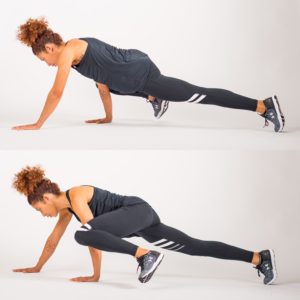
Train antagonist muscle
Here the antagonist muscles are biceps, deltoid posterior, back muscle and trapeze.
To not cause muscle unbalance and risk injuries, you should work on those muscles as much as you work on the muscles used in push ups.
You can do simple exercise like rows if you have access to the proper equipment or barbell. Pull up are great if you want to stick to body weight exercise.
Push up benefits
Health and Sport
It’s possible to do a cardio vascular work while still reinforcing muscle while doing push up. For most people the number of push up you can do is enough to be muscular endurance work. Why ? Because our body is not in general heavy enough for it be strength work (1-5 repetition) or volume work (6-12 repetitions). Don’t worry if you can’t do that much push up in a row, a progression program is possible.
One of the big improvement from push up on other classic pec work like the bench press for example is the core work. When you do push ups you have to engage your core to stabilize your body.
The tension being present in multiple muscular group, it favors muscle coordination.
It’s also going to help with your posture and how you straight you keep your back.
Even if it’s not the priority, aesthetically speaking you’re gonna see changes. Your shoulder are going to get larger and your pec will get some volume. Don’t go past this very efficient basic exercise.
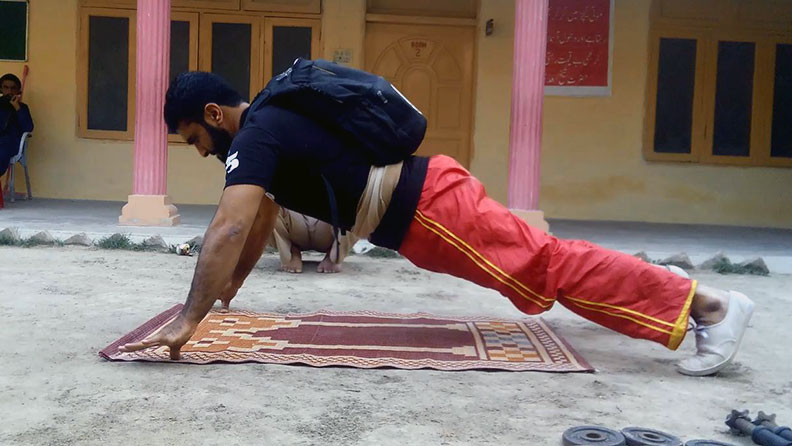
For martial art and fighting sports
Push ups are useful for every practitioner of martial art because it reinforces arms. It also trains force transmission between your core and your arms, which is very helpful when trying to punch.
In grappling sports the contraction will rather be isometric and slower than in striking sport. Those one generally require movements with more speed, more relax and therefore a faster contraction.
It’s easy to adapt your push up work to your specific sport. For example slow push up locking at the bottom and at the top for grappling sport. And more plyometric push up for striking sports.
The different contractions
Classic push up (Concentric-eccentric)
Imagine you’re practicing your push up in a classic way, shoulder wide apart and keeping your elbow close from your body. In a classic schema we are going to do our push up at a moderate speed, without locking at any point, trying to have a smooth movement.
The concentric contraction represents the shortening phase of your muscle, meaning when you go up. It therefore starts from the lower position and stop at the highest one.
The eccentric contraction is the phase where the muscle gets longer. It means it’s when you’re getting close from the ground. It starts from the top position and finish on the bottom.
For these push ups speed is going to be the factor changing what you work specifically.
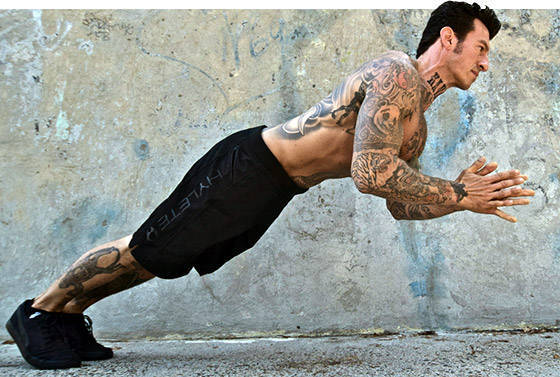
Isometric push up (Core and abs work)
Isometric work allow to gain in strength quickly, but only in the angle practiced. The muscle doesn’t get any shortening or lengthening phase.
The isometric work is all about keeping a static position, like doing classic core work such as a plank. To adapt it to push up, you can lock your position at the height you want. Generally it is better to lock it up at 90 degrees since it’s the hardest position.
Plyometric push up
In this variation we can work the power of the muscle (also called explosivity), which is a very important part of martial art and fighting sports.
An example of a plyometric push up is a clapping push up. The goal is to exert the maximum of explosivity so you can jump and clap your hands before getting back down. The landing part is also a very good work since it works your whole body trying to stabilize the descending force.
Push up with stabilization using an exercise ball
Very useful to maintain your joint in good shape and work on all the micro muscle that stabilize your body. You can do those push up by putting your hands on a Swiss ball, or putting your legs instead (will work more on the core).
The advantage of this variety is that your body has to constantly balance itself, which is done by stabilizing muscle. Those muscle are the one keeping you uninjured when you do a bad landing, you fall etc.
Push up combined with different exercises
Burpees

Burpees are not really part of push up (strength work) since it’s as much cardio, but it’s a good example to demonstrate the versatility of the exercise.
Simply jump while throwing your arms in the air, then go down, do a push up, and restart the movement. It’s a good movement that work on the cardiovascular system in a full body way.
Spider man crawl
Interesting variation because it’s a moving one. It therefore works on balance and stabilization when the number of contact point between the ground and you change. Helps greatly with grappling sports.
Keep challenging yourself and changing
Look at this video for a good idea on change and variation
Conclusion
To conclude, a lot of different push up variation exist. You just need to create yourself a program adapted to your personal objectives (cardio or strength work).
It’s a very basic exercise but it can be very efficient. It also takes little to no time and can be done along core exercise before you go to sleep for example.
If you have trouble doing a normal push up, start with wall push up, then move to knee push to end up doing real push ups.
More informations about push up progression in this video :


